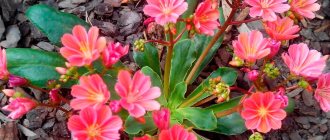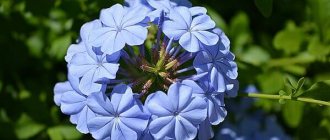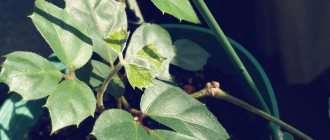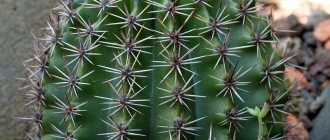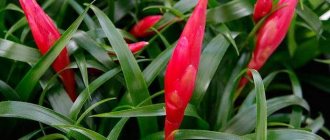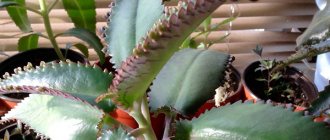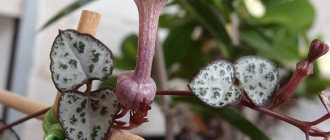Lighting
Mühlenbeckia prefers more diffused light , but can also grow in partial shade. The flower needs some direct sunlight in the morning or evening.
It is recommended to place the flower in the western or eastern part of the room, since if you place it in the north, the stems will grow thin and elongated.
If you placed Muehlenbeckia in the southern part of the room, then in the summer, the flower needs to be slightly darkened.
Trimming Features
Liana is easy to shape. Reacts calmly to pruning, pinching, and haircuts. It is possible to tie it to any support - flexible branches do not break under mechanical stress. After pruning, it quickly grows and gains density. The optimal time for pruning is the entire summer period.
They focus not so much on timing, but on the aesthetic component - they trim the vine as it goes beyond the permissible growth limits. After a warm winter, it is recommended to carry out major pruning in early spring - shorten all elongated shoots to stumps. The crown will again become neat and attractive.
Mühlenbeckia is a semi-deciduous vine. The lower part of the stem gradually becomes bare as a result of the shedding of old leaves. Restore the decorativeness of the flower by rejuvenation. Radical pruning of the plant is carried out to stimulate the growth of new young shoots.
Temperature
A heat-loving flower needs a stable temperature without sudden changes of +20 +24 C, let’s say a short-term minimum of + 17, but you should not keep the vine for a long time at this temperature, this will slow down the growth of the plant.
In cold weather, it is recommended to keep the flower at a temperature of +11 +15 degrees. The leaves of the vine begin to fall closer to winter , do not worry, this is a normal reaction to the change of season.
general description
Belongs to the buckwheat subspecies Polygonaceae. In total, there are just over 20 different species of this ornamental plant.
Belongs to evergreen shrubs. Can be creeping and climbing.
It has chaotically intertwined graceful branched stems. Depending on the subspecies, their length can be from 10-20 cm to 2.5-3.0 meters.
The bark of the trunk is burgundy in color, very smooth.
Leaves have short petioles and are round in shape. The most common are maple or oval. The base of the leaves is heart-shaped.
The inflorescences are miniature and small. May be racemose or axillary. The flowers are snow-white or amber-emerald. They have 5 petals. The diameter reaches no more than 0.4-0.6 mm. The fruit of the plant is in the form of a spherical achene.
Photo of Muhlenbeckia flower:
Soil and fertilizer
Soil is the foundation of a beautiful flower.
Mühlenbeckia prefers fertile and rich soil. It is better to prepare the ground for the vine yourself. It is recommended that the soil contains: good quality sand, humus and turf soil. At the bottom of the flower pot you should definitely make a drainage layer consisting of expanded clay. This will help avoid waterlogging of the soil and rotting of the root system.
It is recommended to feed the vine no more than 3 times a month . It is better to do the procedure with mineral fertilizers for flowering indoor plants.
Important! With the onset of autumn and before spring, the subcort needs to be removed.
Growing
Since Mühlenbeckia is an ornamental vine or climbing frame plant, the shoots of which quickly grow in length, it is better to replant it annually in early spring, and each time you need to take a pot several centimeters wider than before.
The root system of the vine is quite fragile, so you need to act carefully without damaging the thin and fragile roots. It is better to transfer the plant to another container along with a lump of earth.
Mühlenbeckia develops best in nutritious, moisture- and breathable soil. In this case, a drainage layer must be placed on the bottom of the dish.
Adult specimens need to be fed twice a month with complex mineral fertilizer for flowering plants.
Planting and transplanting
Transplantation is carried out once a year and only in the spring, and you need to be extremely careful with the roots of the plant. The transplant sequence is as follows:
- Choosing the right container for muhlenbeckia. The container must be larger than the previous habitat;
- Expanded clay of 1-2 cm is placed at the bottom of the container. The thickness of the layer will increase over time with further transplants, the maximum layer of expanded clay should not exceed 4-5 cm;
- Next, lay the prepared soil;
- The soil under the flower should be moistened and carefully removed from the old place. Young shoots are carefully shaken out, holding them by the base; older shoots are dug out with a spatula;
Important! Transfer to a new location is carried out only by transshipment (that is, with an earthen lump). The roots of the flower are very sensitive even to contact with other objects!
- The root is very carefully placed in a hole previously prepared in a new pot. Next, the flower is covered with soil, and the top layer is lightly pressed down with your fingers.
Green lace muhlenbeckia in a pot
The network of the thinnest, flexible shoots of Mühlenbeckia forms a unique tangled lace, the individual shoots underneath which are almost impossible to distinguish. But I don’t really want to do this. The openwork green miracle in pots fascinates with its non-standard and surprisingly curly crown. Mühlenbeckia, for all its beauty, remains a largely underestimated plant and is not found as often as it deserves. This decorative foliage beauty is capable of growing both as a hanging and bushy plant, can be formed on any support and is absolutely unpretentious.
This amazing indoor plant belongs to the Buckwheat family and came to us from New Zealand and Australia, although some species of Muhlenbeckia can also be found in southern Africa. Muehlenbeckia develops in the form of fairly large climbing or creeping vines, whose red-brown shoots are capable of capturing amazing areas in nature. In indoor culture these are quite compact plants. the genus Muehlenbeckia, only one species is used for indoor cultivation - Muehlenbeckia complexa.
The height of this beauty can reach either a modest 15 cm or almost 1 m: the specific dimensions of the plant always depend on the support and form of cultivation. Thin, retaining their reddish bark, and very flexible shoots are capable of entwining any support, creating a delightfully lacy, cloud-like crown, effectively decorating various containers, niches, arches, planting greenery on walls and various structures. The thin branches of Mühlenbeckia are so densely intertwined with each other that it is not possible to trace the lines of individual shoots.
They form a kind of green lace, a tangled mass that is perceived as an amazingly beautiful vision. The long shoots of Mühlenbeckia are decorated with elegant, but small, charming leaves with a glossy color located alternately on the shoots. The leathery round leaves reach only 2 cm in diameter, but most often they are much smaller and do not exceed 0.5 cm in diameter. The color of young leaves is brighter and more saturated, while old ones are darker and muted, so you can see greenery with a variety of shades of color on the plant.
The red tone of the shoots, reminiscent of strings, perfectly emphasizes the play of color nuances of the foliage. Indoor muhlenbeckia usually blooms in August. The flowers reach only 0.5 cm in diameter and bloom in the axils of the leaves in small panicles of 2-5 pieces. Even though the ineffective, small white flowers do not seem too modest on the plant, they exude a very pleasant scent. This aroma in the fresh air attracts butterflies en masse to Muehlenbeckia. After flowering, the plant is decorated with achenes.
Muehlenbeckia complexa or Muehlenbeckia complexa. © floradania
Plant propagation
Mühlenbeckia can be propagated in several ways:
- Dividing the bush when replanting, but this must be done very carefully so as not to damage the root system of the plant;
- For upper cuttings, it is enough to cut the cutting at least 10 cm during the growth period and place it in water. After 14 days, the shoot will have roots. After which the shoot can be transplanted into the ground, 6-7 pieces per container.
- Seeds. Artificial pollination produces seeds that are sown in peat-sandy soil in the spring. As soon as the seeds produce the first leaves, they can be transplanted into separate containers of 3-4 pieces;
- By layering. One shoot from the bush is placed deeper into the soil, and after 16 days it is cut off from the main plant and transplanted into a separate pot.
Mühlenbeckia - a bright vine with pearly leaves
Mühlenbeckia is a very elegant liana-like plant of the Buckwheat family. It is common in the forests and foothills of Australia and New Zealand, and some varieties are found in South America. The Mühlenbeckia plant has long been loved by gardeners for its thick crown with many small emerald leaves. In our latitudes it is grown as an indoor hanging plant.
Botanical characteristics
The genus Mühlenbeckia includes about 20 species of semi-shrub and creeping perennial plants. They have a fibrous root system. A bunch of reddish stems forms above the surface of the ground. The growth is characterized by a creeping or creeping character. The stems are highly branched and intertwined, forming a lush green mop. The length of the stems can vary from 15 cm to 3 m. The stems are covered with a smooth reddish bark, which gradually becomes lignified and darkens.
Along the entire length of the stem, successive small leaves on short petioles are formed. The shape of the leaves is round, oval or lobed. The surface of the leaf plate is smooth and shiny. The length of small bright green leaves is 6-20 mm. The plant is semi-deciduous and loses some of its leaves in winter.
The flowering period occurs in August. The liana produces rare axillary paniculate inflorescences consisting of 1-5 small white-green flowers. The five-petal bell is only 5 mm in diameter. The flowers emit an intense sweetish aroma. When placed on a balcony, blooming muhlenbeckia will attract many butterflies and other insects. After wilting, a miniature edible achene with many small seeds is formed in place of the flowers.
Types of muhlenbeckia
Before you buy muhlenbeckia, you should study the existing varieties and choose the most interesting one. In a small genus, only 20 varieties are registered, but only one species with several ornamental varieties is used in culture.
Mühlenbeckia tangled. Its thin, reddish-brown stems are covered with small, rounded foliage. The leaves are attached to very short petioles. The length of the leaf plate does not exceed 1.5 cm. The shoots reach several meters and beautifully fall or entwine various supports. Small snow-white flowers bloom in August and cover the entire length of the stems.
Popular varieties:
- Mühlenbeckia grandiflora - distinguished by larger (up to 2.5 cm) oval leaves;
Reproduction
The liana is propagated by seed and vegetative methods. You can buy muhlenbeckia seeds online or at a flower shop, or you can try to collect them yourself. After pollination, the achene ripens within a month, then it is picked, opened and the seeds are dried. Seeds remain viable for up to 3 years. In the spring, seedlings are sown in flat containers with a light sandy-peat substrate. Seeds are placed on the surface without deepening. The bowl is covered with film. Shoots appear within 1-2 weeks. The cover is removed after seedling germination. When 4 true leaves appear, the seedlings are planted in separate pots.
The easiest way is to root cuttings. It is enough in spring or summer to cut young stems into 10-12 cm pieces and place them in water for rooting. With the appearance of the first roots, the cuttings are planted in pots with soil for adult plants, 4-5 pieces each.
You can also propagate muhlenbeckia by layering. To do this, part of the stem, without cutting it, is sprinkled with earth. Roots will begin to form in this area. After two weeks, the rooted shoot is cut off from the mother plant and replanted.
Plant care
Mühlenbeckias are very unpretentious and require very little care at home. Liana does not like direct sunlight, but develops well in the shade. You can place a pot with Muehlenbeckia in the center of the room, on a cabinet or near east and west windows. In the bright sun, the tender leaves quickly fade and begin to dry out.
The ideal temperature for tropical vines is +20…+24°C. In winter, it is recommended to provide the plant with a period of rest and move it to a cool room (+10...+14°C). At this time, partial leaf fall is observed, which should not cause concern. Mühlenbeckia is afraid of drafts and reacts poorly to sudden temperature changes, so it needs a quiet, protected place.
Mühlenbeckia is unpretentious in terms of soil composition; it tolerates acidic, neutral and slightly alkaline soils. It is important that the substrate is light and breathable. The soil can be composed of the following components:
The pots are selected to be small, since the rhizome is located on the surface. It is important to provide a thick drainage layer of clay cuttings, vermiculite or pebbles so that the roots do not rot from excess moisture. It is recommended to carefully loosen the soil surface from time to time.
The transplant is carried out very carefully. There is no need to completely shake off the soil from the roots. You can use the method of transferring an earthen clod.
Mühlenbeckia loves frequent watering; only the upper part of the soil should dry out. It is recommended to water the plant with small portions of settled, soft liquid. In April-October, a universal complex of mineral fertilizers for green indoor flowers is added to the water. Fertilizer is administered in liquid form twice a month.
Air humidity is not particularly important for Muehlenbeckia. In extreme heat, spraying the leaves will allow the plant to maintain its attractive appearance. Moisture on leaves and flowers does not cause diseases or other defects.
The plant has good immunity to known diseases and parasites. With improper care and excessive watering, root rot can develop. At the initial stage, you can still try to dry the soil and treat the roots with an antifungal drug. In advanced cases, the plant is rejuvenated using cuttings and the affected parts are completely removed. It is also important to completely replace the soil.
Pests and diseases
Mühlenbeckia practically does not get sick and is not affected by pests , but with improper care and maintenance the following diseases may appear. Most often, a vine can suffer from:
- If the air in the room is dry, the leaves of the flower may turn yellow. To prevent this, it is necessary to do frequent spraying and maintain humidity in the room;
- Falling shoots and drying leaves. In this case, the flower must be moved to a dark place and prevent direct sunlight;
- Root rot. To avoid this disease, it is necessary to monitor the soil of the flower and avoid excessive moisture. If the plant is still sick and the roots have rotted, then the bush must be removed from the ground and the affected roots removed. The cut must be sprinkled with charcoal or sulfur;
Mühlenbeckia is not considered a capricious flower. With proper care, care and attention, the plant will respond with its gratitude, giving birth to wonderful green flowering shoots.
First steps after purchase
When choosing a Mühlenbeckia that you like in a flower shop, you should carefully examine its leaves. If a plant is damaged by small insects, it is better not to buy a specimen, since it may die from inexperienced gardeners.
At home, the plant tolerates partial shade, so you can place it away from the window in a suspended state or on a windowsill, preferably on the north side.
Isabella grapes - description of the variety and its characteristics. Planting, care and processing features of a popular vineyard (115 photos + video)
On the first day, it is recommended to water Mühlenbeckia a little with water at room temperature, but not too much, so as not to flood the roots. The optimal solution would be quarantine for two to three weeks.
Main types
If you decide to purchase this hanging plant, you need to familiarize yourself with the existing ornamental varieties in order to choose the most interesting one for yourself.
There are some varieties of decorative muhlenbeckias, differing in the shape of the leaves:
- Grandiflora (Grandifolia) - has large oval leaves (2.5 cm).
- Covering (Сomplexa) - there are small rounded leaves 1.5 cm in length.
- Microphylla - has medium-sized rounded leaves.
- Nana (Nana) - has the smallest leaves, densely located on the shoots.
- Maori (Maori) - oval leaves (2 cm) have a reddish base and petioles.
- Tribolata cheese - there are leaves with three pronounced lobes.

